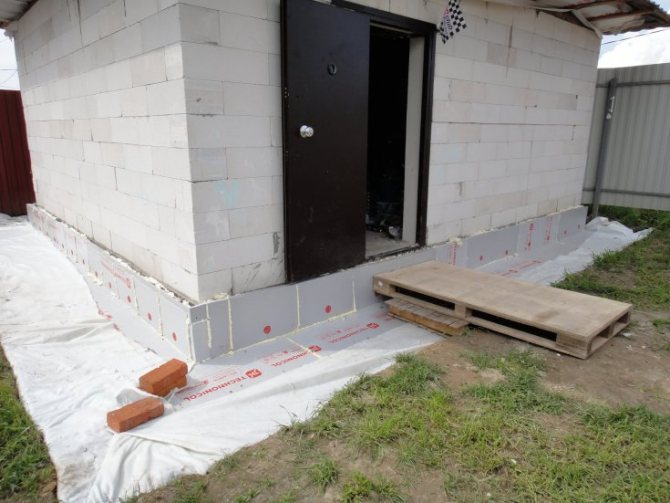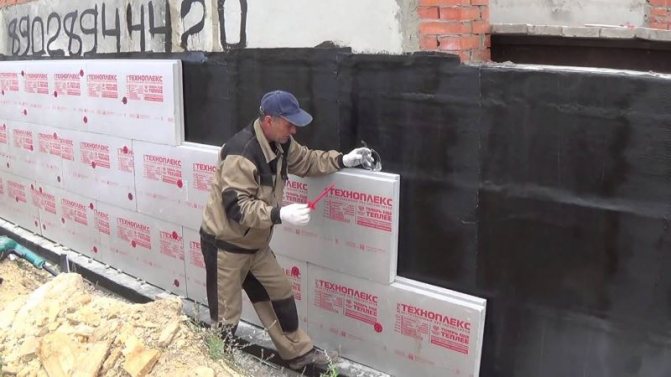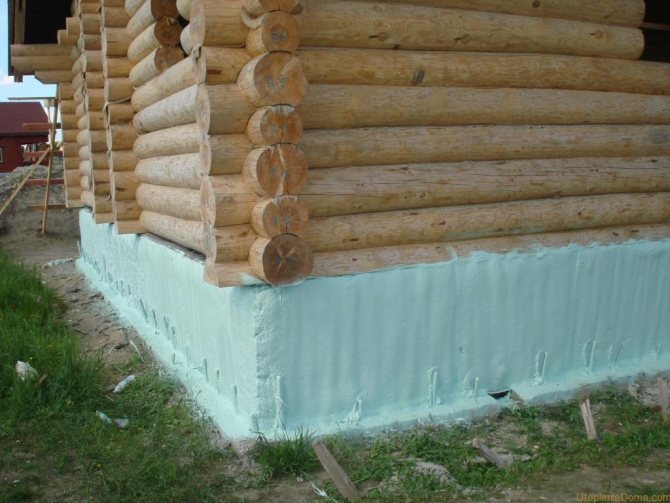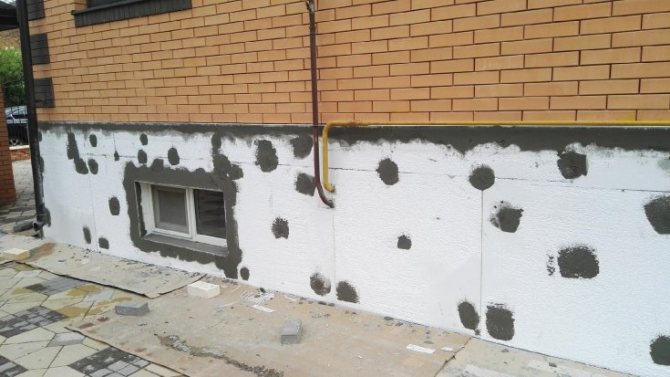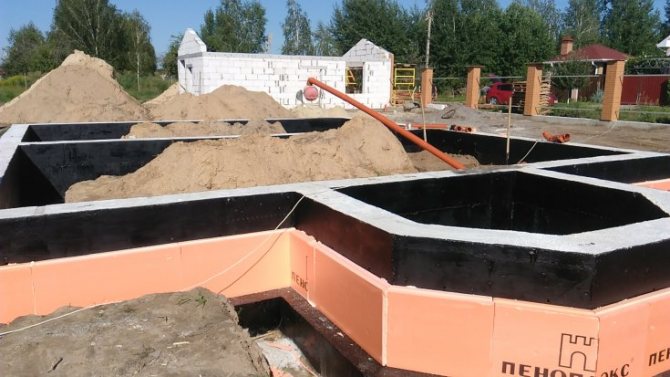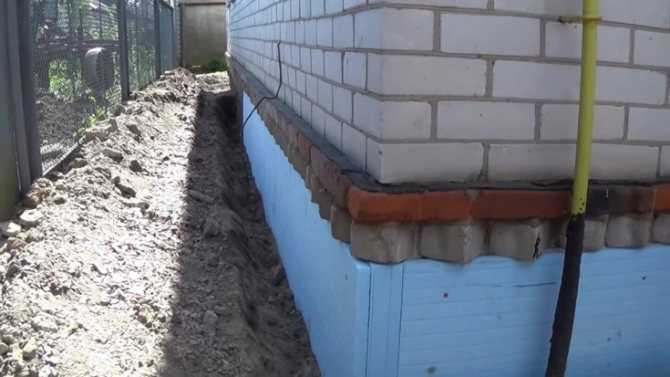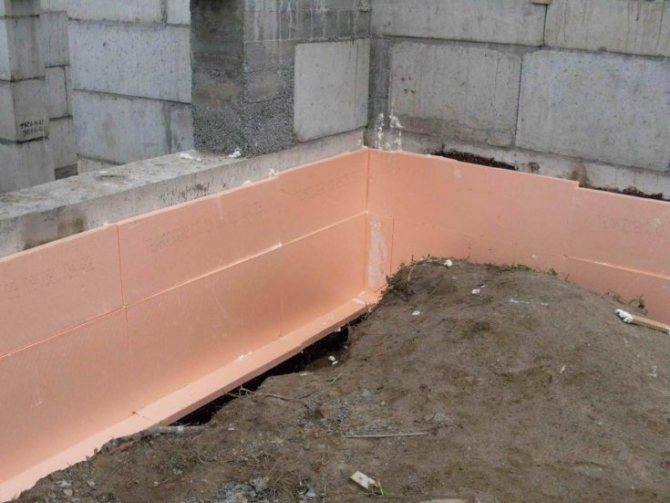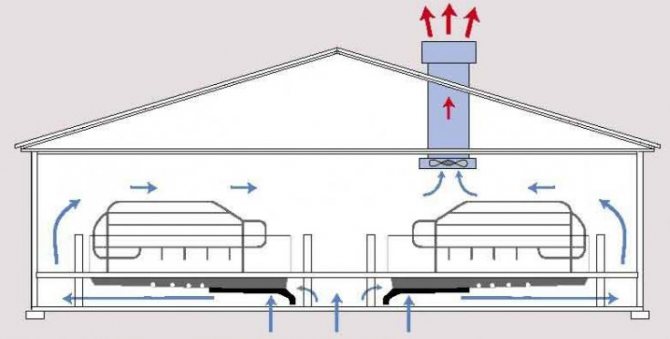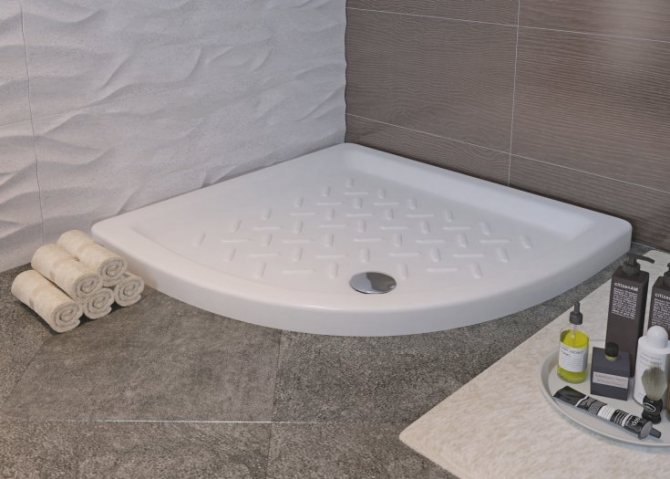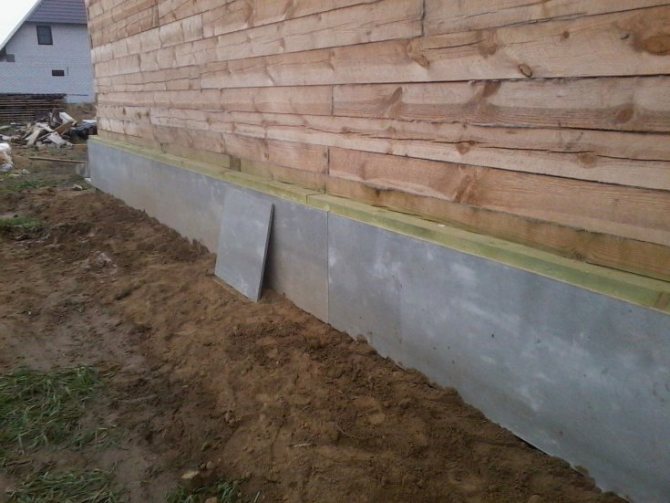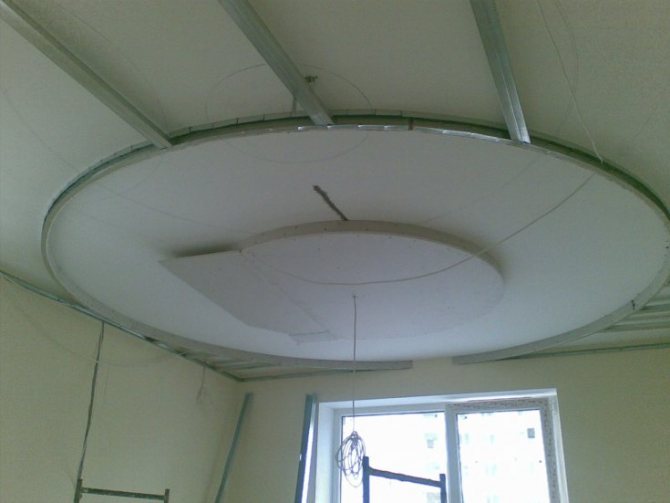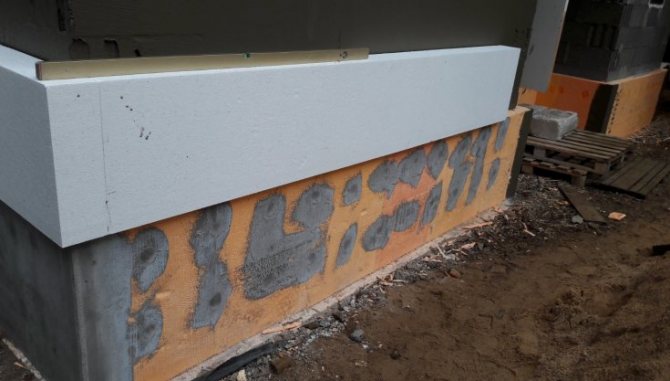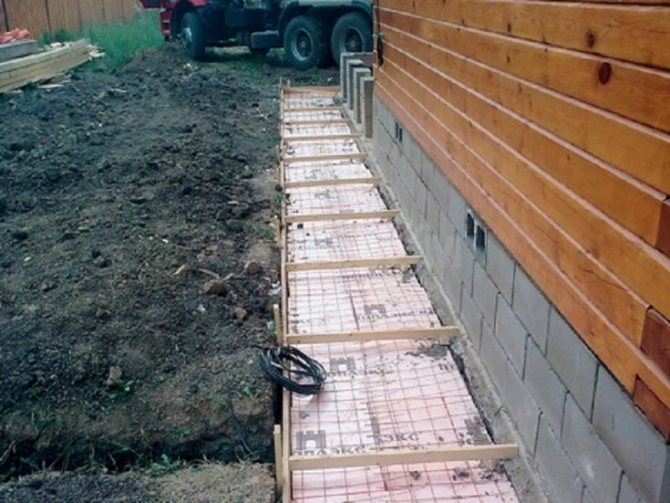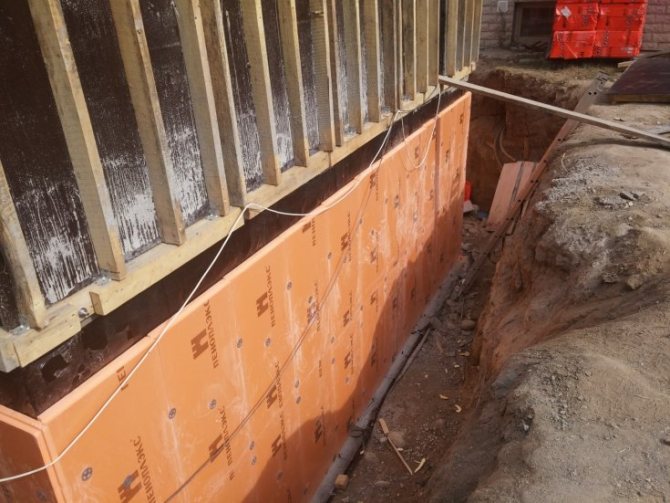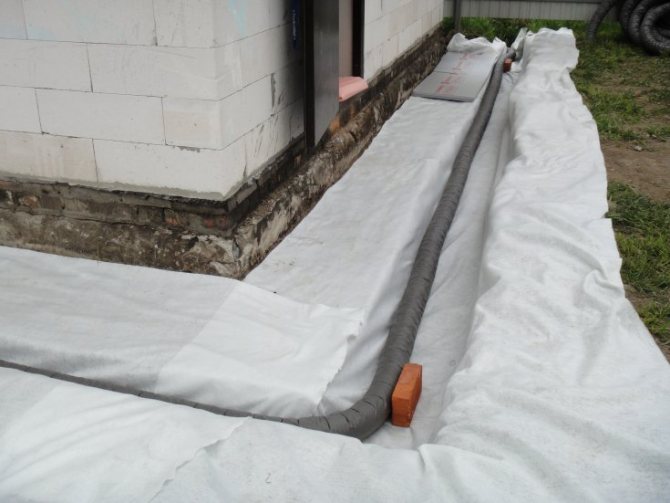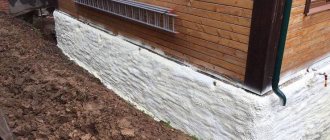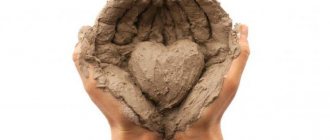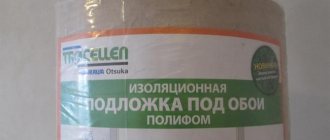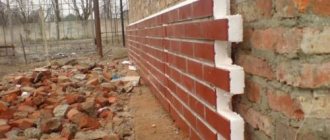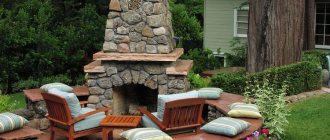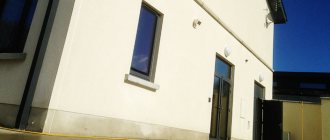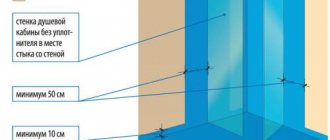How to insulate the foundation
Insulation of the foundation with polyurethane foam is considered expensive, but it pays off in the near future - the cost of insulating a house with such insulation is minimal.
Insulation of the foundation with extruded polystyrene foam. The material is similar to polystyrene, but stronger than it and contains air cells that increase its thermal insulation properties. It is produced in the form of plates, convenient for installation.
- The foundation is cleaned of dirt and waterproofed with polymer or bitumen mastic.
- Prepare a glue for polystyrene and apply it to the inner surface of the plates. If the foundation is uneven, it is enough to apply glue where it touches the insulation.
- The slab is pressed against the foundation for a few seconds and leveled if necessary.
- The next plate is mounted by aligning the connecting groove.
- It is not necessary to fix the penoplex to the underground part of the foundation - the slab will be securely fixed when backfilled with soil.
- When the glue dries, the material is additionally attached to the foundation using dowels.
Foundation insulation materials and technology
With the existing variety of heat-insulating materials, foundation insulation is most often performed with extruded high-density polystyrene foam EPS, XPS, Carbon SP from Technonikol, Penoplex Foundation. Unlike mineral, glass and ecowool, polystyrene foam retains its heat-insulating properties, even when completely immersed in water. For comparison, basalt wool loses 30% of its properties when wet, and begins to slide from vertical surfaces under its own weight. It is prohibited to rely on soft insulation of concrete structures.
Heaters
To protect the foundation of a private cottage, the following thermal insulation materials are most effective:
- polyurethane foam - PPU marking, sprayed on the surface, also available in the form of plates, density 50 - 60 kg / m3, thermal conductivity corresponds to 0.028 units, costs twice as much as expanded polystyrene;
- extruded polystyrene foam - different designations from manufacturers, plates of different sizes, density 35 - 45 kg / m3, thermal conductivity 0.03, is cheaper than the previous version.
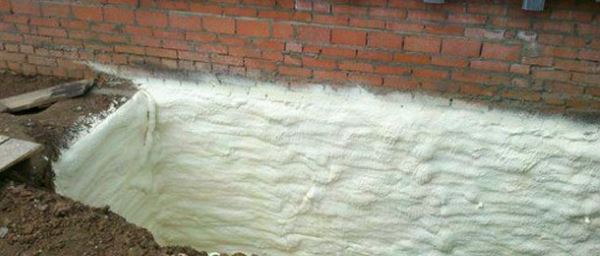
Insulation of the foundation with polyurethane foam.
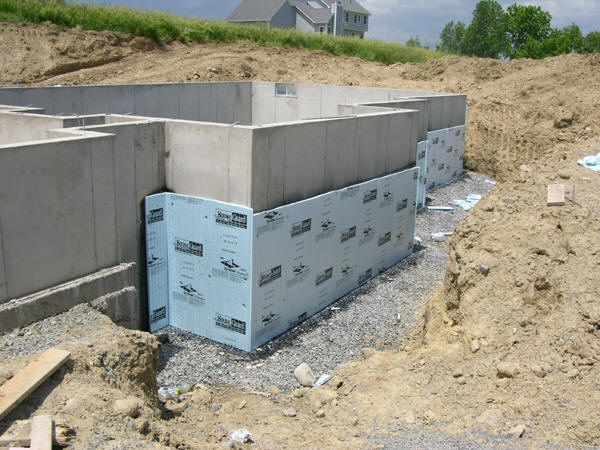
Insulation of the foundation with extruded polystyrene foam.
The polyurethane foam used to fill the seams of the insulation is made of polyurethane foam. Therefore, when using Penoplex, EPSS, the quality of the joints is higher than that of the main surface.
The main disadvantage of expanded polystyrene is its low chemical resistance - the material is dissolved by petroleum products. Therefore, it is not recommended to glue over concrete surfaces treated with bituminous mastics, melted roll materials that have a bitumen layer. It is better to use polymer mastics, membranes or plastic films. Polyurethane foam is inert to petroleum products, acids, alkalis and salt solutions.
The budgetary foam PSB-S has a density of 15 - 25 kg / m3, a thermal conductivity of 0.04 units, and a vapor permeability of 0.05. This insulation is used in cases:
- outer layer of vertical crushable insulation;
- fixed formwork for low grillage (lower horizontal deck).
In the first case, a heater is needed to protect the main layer of the heat insulator. In the second version, the foam remains after the grillage is poured under the reinforced concrete structure, it is crushed by the soil when swelling so that the heaving forces cannot tear the grillage beams from the pillars or piles, the heads of which are embedded in the structure.
Technology overview
Warming of the foundation is carried out according to different schemes, depending on the operating mode, design. Swelling protection is necessary for columnar, strip and slab foundations. The heaving forces practically do not act on the piles, however, with a low grillage on bored, screw piles, the beams must be placed at least 10 cm above the ground.


The scheme of insulation of the foundation and the blind area outside for a house with constant heating.
There are three main operating modes at home:
- constant heating - they reduce heat loss with insulation, expand the zone of non-freezing soil around the building and protect the foundation from the effects of negative temperatures;
- heating is completely absent - in this case it is pointless to eliminate heat loss, however, it is necessary to preserve geothermal heat under the building in order to exclude freezing of the soil, therefore the blind area + the entire perimeter of the garden house under the sole is insulated;
- heating is switched on periodically (baths and summer cottages) - since there is occasional heating, it is necessary to reduce heat loss in ceilings and floors, the outer surface of the grillage, tape, slab and blind area is insulated, in the absence of heating, it becomes necessary to preserve the heat of the bowels, therefore the entire perimeter of the house is insulated under the sole foundation.
In garden houses without heating, laying polystyrene foam at the level of the basement sole is not always economically viable:
If the depth of the pillars or MZLF is within 40 cm, it makes sense to make a pit, since the fertile layer will still have to be removed completely in order to make the floors on the ground.
If the tape or columnar foundation lies deeper, earthworks can be avoided by laying insulation according to a different scheme:
- under the blind area - the perimeter of soil freezing is moved back;
- under the sole of the foundation - protection against swelling;
- on the inner surface of the tape + under the floor along the ground - preservation of geothermal heat under the entire foundation structure.
If, for some reason, it is impossible to fill the pits sinuses with non-metallic material, in which there is no clay and, accordingly, frost swelling, instead of the standard insulation of the outer surfaces of the strip foundation, a crusher-sliding thermal insulation scheme should be used:
- pasting of external concrete vertical surfaces with high density polystyrene foam;
- covering it with polyethylene (attached only in the basement part);
- installation of low-density foam PSB-S close to the film without fastening (pressed by the backfill material).
This option is especially relevant for deep belts. The area of contact of the side surfaces of the belt with clayey soils is enormous, and the pull-out loads are very significant. When heaving forces occur, the soil crushes the foam, displaces it upward along the slippery film. No harm is done to the main layer of insulation, after the spring thawing of the soil, the outer layer shifts down again.
Important! Warming is just one method of eliminating swelling in a set of measures. Therefore, drainage and non-metallic materials in the underlying layer, backfilling of the sinuses cannot be canceled.
In classical technologies of monolithic foundations (slab, tape, pillars), a screed is used to reduce the lower protective layer of concrete, level the base, eliminate leaks of cement laitance from concrete at the time of pouring.
If a building with a seasonal, periodic operation mode is insulated with a layer of polystyrene foam around the entire perimeter of the pit, then there is no need to make a foundation. That allows you to slightly reduce the construction budget.
The need for the implementation of external insulation
It is believed that it is the basement that belongs to the most vulnerable part of any building.This is due to the fact that this part of the building structure experiences significant loads exerted by the weight of the floors and load-bearing walls. This structural element is located underground, which is why it is regularly exposed to temperature changes and high humidity, and in winter it can freeze through, and the soil heaves under the foundation.
The basement is a continuation of the plane of the building's foundation, which rises above ground level, then passing into the outer walls of the house. In other words, this part of the building is an element that connects the foundation with the plane of the load-bearing walls, which start from the plane of the ground floor. The main function of the plinth is to protect the building from high humidity and the penetration of cold air masses inside. In addition, houses with a basement floor have a more well-groomed appearance.
Carrying out work on the external thermal insulation of the foundation of the house allows you to prevent freezing of the basement and the building material of the basement itself. As a result of such measures, the dew point shifts closer to the insulation material, and it is known to be more resistant to high humidity and negative temperatures than the basement building material. Upon completion of the work, the basement becomes a warmer room, and the building itself gets the opportunity to operate longer.
Thermal insulation technology
Carrying out measures for the thermal protection of the outer area of the basement with your own hands consists in installing EPPS plates in compliance with certain rules. You need to start work with the treatment of a waterproof membrane with a special adhesive. It is on this composition that insulation materials will subsequently be installed.
A special profiled membrane is placed on the outside of the base / plinth. Its main purpose is to remove moisture from the soil located next to the base of the base. In addition, the membrane will protect the thermal insulation from harmful factors. A geotextile layer is laid on top of the membrane. Its main function is a filter.
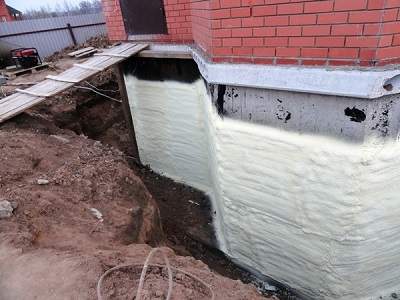

Looks more aesthetically pleasing and easier to apply
Carrying out the listed works, which are aimed at insulating the basement from the outside, the main thing is to make sure that cold bridges do not form. For this, the heat-shielding layer must be overlapped with the materials used to insulate the walls of the structure. In order to save money, extruded polystyrene foam is left unprotected - it is simply sprinkled with earth. The unique qualities of the product will help him cope with various negative phenomena on his own.
The cladding and insulation of the basement, towering above ground level, is performed with the same penoplex along with plaster. A variety of decorative materials can serve as an alternative. For example, artificial stone, which gives buildings an impressive, modern and at the same time mysterious look.
As a result of the work carried out, an insulation system should be formed that will maintain the same temperature at the base of the structure - approximately + 100C. Don't forget to create a good microclimate too.
Tips and useful information
Insulation of the basement solves two essential tasks.
- protects the building from premature destruction;
- minimizes heat leakage, increases the efficiency of building use.
In regions where there is a strong freezing of the soil, the thermal insulation of the basement is mandatory. You can, of course, not do it. But then do not be surprised when cracks appear in the base.
It is advisable to think over the issue of thermal insulation of the basement even at the stage of drawing up the project.Then the construction of the house will immediately be carried out in a comprehensive manner, and then there will be no need to re-excavate the soil or perform other work.
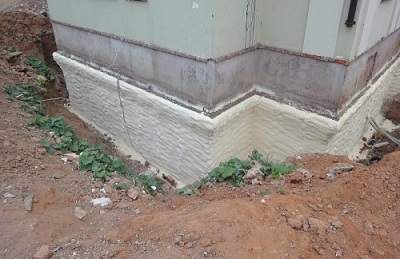

Every house needs to be insulated
A good alternative to penoplex can be polyurethane foam. It is a composition that is sprayed onto the surface with special installations. In this case, the work time is significantly reduced, and the finished insulation layer is many times superior to polystyrene foam boards.
What you need to know about finishing
Insulation and cladding of the basement can be done in one step. This makes sense, because the thermal insulation system should not be left unprotected. Facing with any decorative material will cope well with such functions. For example, stone or clinker tiles.
Clinker tiles have a definite plus, as they are highly resistant to moisture. The material does not need to be treated with additional compounds. In addition, it is very beautiful, easy to apply to the surface and has good durability.
At the same time, the stone has a presentable appearance. As a decoration, you can use granite, marble, limestone.
Do-it-yourself thermal insulation
The choice of insulating materials is very diverse. But the above criteria are fully met only by heat insulators in the form of plates and polymer materials applied by spraying. Their main qualities are discussed in more detail below.
Styrofoam
Polyfoam or expanded polystyrene has long been known as a heat insulator and has not lost its popularity for many years. It has the property of perfectly retaining heat, does not absorb moisture and its vapors, is easy to cut and has a low weight, which means it is easy to install. In addition, expanded polystyrene has a low price when compared with other polymeric materials for insulation. All these advantages make the foam popular for arranging thermal insulation over a large area or limited financial resources.
For the production of work on the thermal insulation of the basement, foam is suitable, belonging to the brands PSB-C 25 or PSB-C 35. These varieties have a higher level of density, which means they can better withstand the effects of mechanical stress. The thickness of the slabs can vary from two to ten centimeters.
Depending on the characteristics of the climate in the region of construction, the insulation can be laid in one or two layers. The material is able to withstand significant temperature changes - from -60 degrees to 80 degrees, while its characteristics will remain unchanged. Polyfoam is not afraid of either winter cold or summer heat.
Despite the impressive list of advantages, polystyrene also has its own disadvantages:
- weak level of bending strength;
- high level of fragility;
- attracts mice and rats.
Extruded polystyrene foam has a denser structure than polystyrene foam. Its cells are very small and do not exceed one millimeter in diameter. Due to this, the EPSP practically does not absorb moisture and has significant mechanical strength. The insulation has a high degree of resistance to chemicals, harmful microorganisms, deformations associated with shrinkage.
Expanded polystyrene produced by extrusion is in high demand. the most popular was the material under the brands URSA, Styrofoam, Penoplex, TechnoNIKOL XPS. They are produced in the form of plates with various thicknesses and densities. Standard sheet sizes are 120 * 60 centimeters or 240 * 60 centimeters.
We suggest that you familiarize yourself with Knitting reinforcement: methods, schemes, norms and rules for knitting for beginners
The main disadvantage of extruded polystyrene foam is the high level of flammability of the material.All major brands of this insulation belong to the G4 or G3 flammability class. When the material smolders, poisonous substances are released into the air.
Polyurethane foam is able to simultaneously provide your home not only with thermal insulation, but also protect against high humidity and the penetration of extraneous sounds from the outside. The material is suitable for use in various parts of the building - roof, attic, foundation, etc. It adheres perfectly to the base of any material.
The task of competently insulating the basement floor in accordance with the necessary standards and technical indicators, with the arrangement of a suitable thermal insulation system, sometimes seems at least difficult, at most impossible. In reality, you do not have to perform any too complex actions.
Among the wide variety of modern heaters, only polymer-based plate and spray materials fully meet the above requirements. Let's consider their characteristics in more detail.
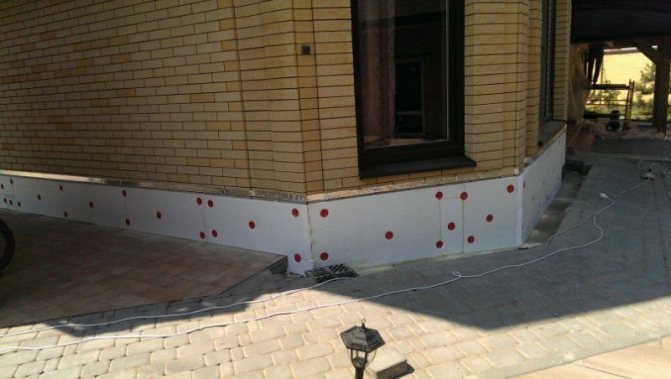

Warming with expanded polystyrene
Expanded polystyrene (polystyrene) has been used as a heater for a long time, and still does not give up its positions. It retains heat excellently, does not accumulate moisture, is easy to cut and is lightweight for effortless installation. In addition, polystyrene has the lowest cost among other polymeric heaters, and this is a weighty argument in its favor for thermal insulation of large areas or a limited budget.
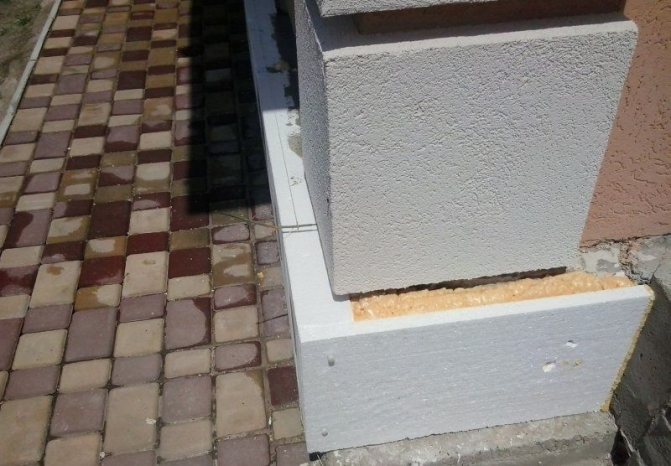

Insulation of the basement with foam
To insulate the basement, it is necessary to choose polystyrene of the PSB-S 25 or PSB-S 35 brand, which is characterized by increased density and resistance to mechanical stress. The thickness of the slabs varies between 20-100 mm, and depending on climatic conditions, the insulation can be laid in 1 or 2 layers. The material withstands temperature drops from -60 ° C to 80 ° C without changing its characteristics, so it is not afraid of the most severe frosts and summer heat. The service life, on average, is 25 years, and with a high-quality arrangement of the heat-insulating pie, it will be 10 years longer.
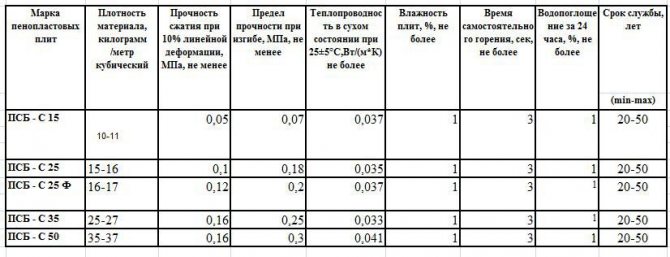

Styrofoam characteristics
Despite all the advantages, foam plastic also has disadvantages: it has low bending strength, that is, it is quite fragile, and is often damaged by rodents.


The mice gnaw through the insulation
In addition, in the absence of waterproofing, moisture penetrates into the upper layers of the material and, freezing, provokes crumbling of the slabs.
It is easy to insulate the basement part on your own, the main thing is to follow the technology exactly. One of the most important conditions is the high-quality preparation of the base. If the house is new, the basement and the blind area are in good condition, then the work process will not take much time, which cannot be said about old buildings.
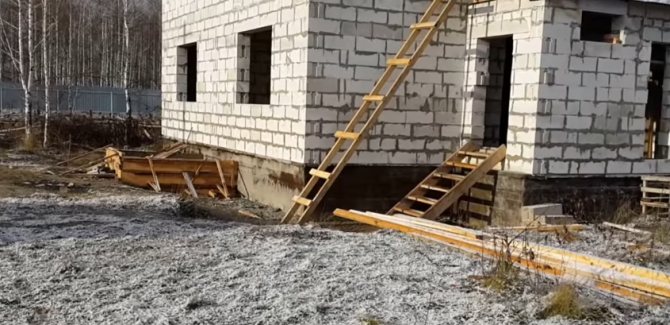

The facade of the house before insulation and finishing. In the photo, the base does not need preparation
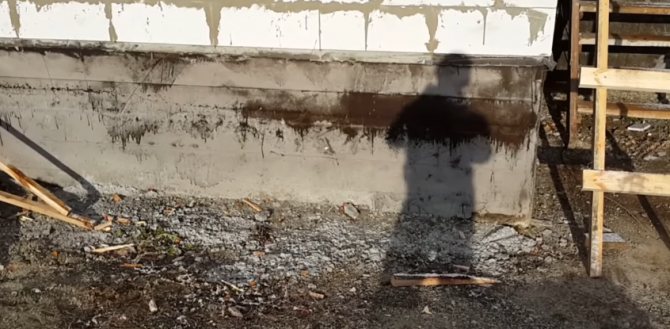

Plinth close up
The work of cleaning the surface from dirt begins. If the plinth is finished with tiles or facade panels, the cover will have to be dismantled. They clean off the old plaster, knock down the protrusions, the dried solution, and thoroughly process the base with a stiff brush.
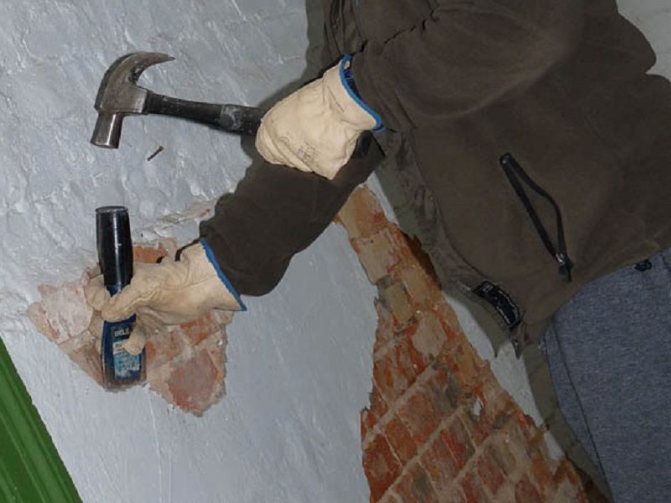

In the photo, a way to remove old plaster manually
In a brick plinth, the seams must be carefully cleaned to reveal voids.


Crumbled mortar from the seams must be cleaned
Next, they carefully examine the base, embroider the cracks, treat the areas affected by the fungus with special means.
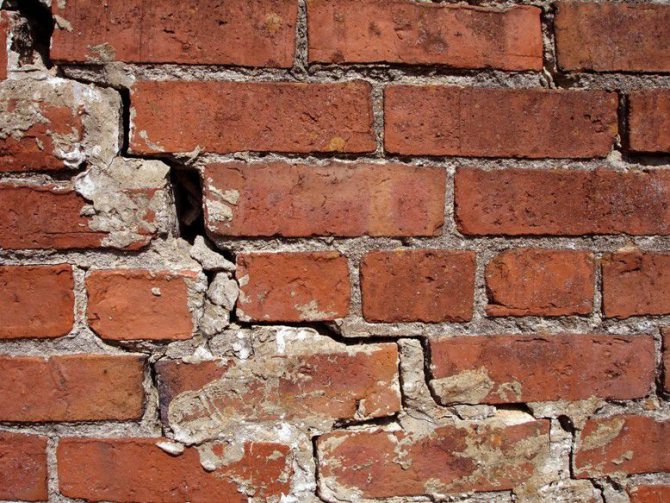

Cracks need to be well cleaned and expanded before repairs.
If the blind area is old, covered with deep cracks, it must also be completely removed, otherwise it will not be possible to insulate the base with high quality. Further, a layer of soil about half a meter wide and 10-15 cm deep is removed along the perimeter of the house.If the blind area is in good condition and fits snugly against the wall, it is enough to clean the joint along its entire length with a metal brush to remove debris and dirt.
We offer you to familiarize yourself with the Foundation of expanded clay concrete blocks with your own hands
For a snug fit of the slabs to the base, the walls of the basement should be as flat as possible. If there are differences of more than 10 mm, the surface should be leveled with plastering. To do this, you can use a conventional cement-sand mortar, but it is better to purchase a dry cement-based mixture.
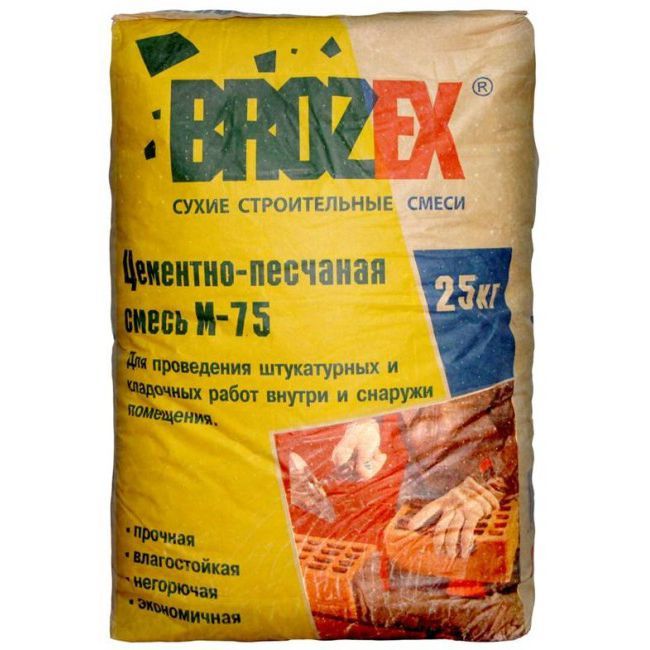

Sand-cement mixture for plaster
Factory mixes are more expensive, but they do not shrink and are more resistant to negative effects. The plaster is applied with a trowel to the wall and spread gently over the surface in a thin layer.


Applying repair mortar
After drying, the walls are treated with a float with an emery cloth, dust removed and covered with a waterproof primer with quartz filler.
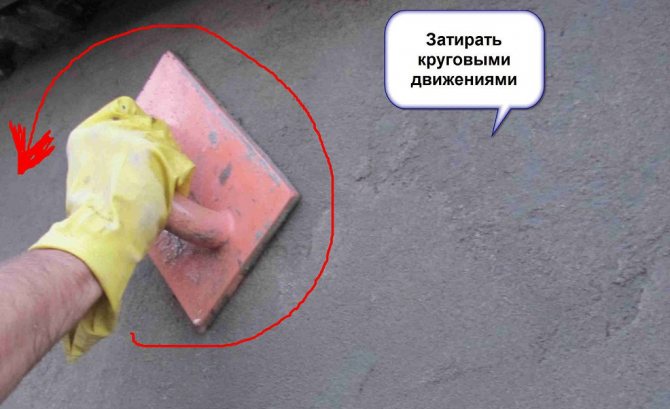

Plaster grout
For insulation you will need:
- EPS boards, for example, Penoplex;

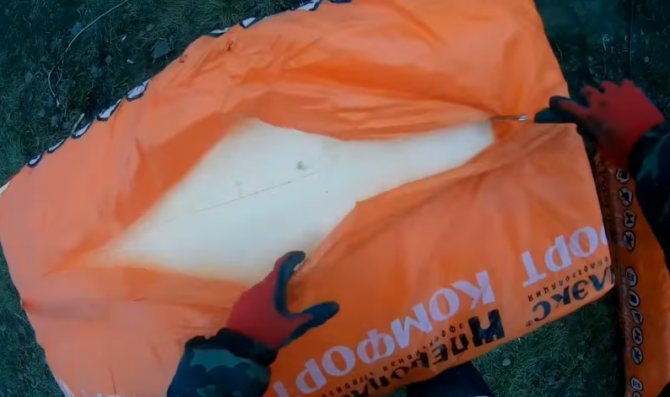
EPS plates - fiberglass mesh for reinforcement;
- glue for expanded polystyrene (Titan, Ceresit ST 83);
- plastic perforated corners with mesh;
- dowels, fungi;
- assembly knife;
- level and tape measure;
- metal spatulas;
- a drill with a mixer attachment and a set of drills.
Construction mixer
It is very simple to calculate the amount of insulation: you need to measure the length of the base around the entire perimeter, multiply by the height and divide by the area of one foam board. The material should be bought with a small margin, since the slabs must be trimmed when joining. In the same way, the amount of reinforcing mesh is calculated, which is necessary when plastering insulation.
Step 1. Slabs are tried on to the surface, if necessary, they are trimmed. The lower edge of the insulation should rest on the concrete base of the blind area or on tightly compacted soil covered with a layer of sand.
Step 2. Glue is applied to the back of the first board in a continuous line along the perimeter and in the middle.
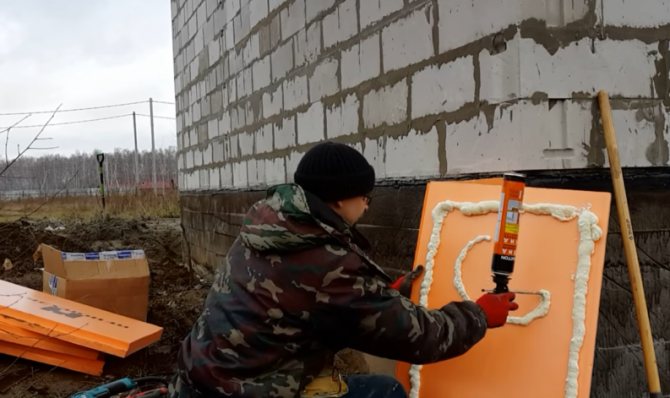

Glue application
Materials for insulating the basement
The problem of insulating the basement can be solved with the help of various materials that provide protection against heat leaks. They must meet a number of established characteristics:
- be durable;
- have the lowest possible moisture permeability;
- do not harm the human body;
- do not be afraid of low temperatures.
Let's analyze the main materials that can be used for these purposes. You can, of course, perform thermal insulation of the basement with mineral wool, but one of the most common solutions is extruded polystyrene foam. The material is perfect for use in the harsh conditions of our winters. It is safe for humans and practically unaffected by the negative effects of low temperatures and water. If done correctly, condensation will not form in such basement plates.
| Mineral wool (mineral wool) | Fibrous material made from metallurgical slags, silicate rocks. Mineral wool is marketed in rolls and slabs. |
| Glass wool | Mineral fiber, like mineral wool, uses the same raw materials as plain glass. It comes in rolls and slabs. |
| Styrofoam (expanded polystyrene). | Gas-filled plastic with a lot of air bubbles. Produced in slabs. |
| EPPS (extruded polystyrene foam). | It is made of polystyrene by extrusion (extrusion). Practically does not absorb moisture. Available in slabs. |
You can, of course, perform thermal insulation of the basement with mineral wool, but one of the most common solutions is extruded polystyrene foam. The material is perfect for use in the harsh conditions of our winters. It is safe for humans and practically unaffected by the negative effects of low temperatures and water.If done correctly, condensation will not form in such basement plates.
Do-it-yourself thermal insulation
In a building with a heat-shielding layer, the area of frost penetration cannot penetrate the house and touch the surface of the base walls. This has its advantages. The full-height strip foundation, from the base to the basement ceiling, will be in approximately the same temperature regime.
Many people ask a reasonable question - what material to choose for high-quality insulation of the foundation? A couple of generations ago, clay-straw mortar was a popular material for thermal insulation of the basement. Over the past decades, technologies for the production of materials for insulation have changed a lot and have become more advanced. New heaters are produced in a form that simplifies their transportation and installation. The requirements for heat insulators have also changed and are as follows:
- Low thermal conductivity. The lower this coefficient is, the higher the insulating properties of your chosen insulation material will be.
- Low moisture absorption rates. A heat insulator, which is able to actively absorb moisture, cannot retain heat well and gradually loses its valuable, from the point of view of the consumer, qualities. This process poses the greatest danger in winter. Water, turning into ice, is capable of disrupting the structure of the insulating material.
- High level of resistance to compression processes. Significant soil pressure is exerted on the foundation, and for the insulation it is important that this factor does not affect the change in its properties.
- Immunity to the influence of harmful microorganisms. If the heat insulator is susceptible to the appearance of mold and mildew, then it can quickly collapse under their influence. In addition, the material should not attract rats, mice and harmful insects.
The cost of activities for thermal insulation of the foundation will largely depend on the conditions of the work. In particular, on when the work is being carried out - in the process of building a house or already during the operation of the building. In addition, the variety of the selected material matters. The main ones are:
- polyurethane foam applied to the surface by spraying;
- heat insulator in sheets - foam, mineral wool, foam, extruded polystyrene foam;
- inexpensive insulation applied by filling method - expanded clay in granules;
- thermal panels are a relatively new material consisting of several layers, which includes: finishing cladding - plaster or facing tiles;
- applying "warm" plaster;
- backfilling a layer of clay or soil.
Is it worth insulating the foundation with polyurethane foam from the inside
Yes, it's worth it. This should be done during the construction phase, when there is access to the interior of the structure. With double-sided insulation, the thermal conductivity of the lower part of the house is significantly improved, and the service life of the foundation is increased.
If a basement or cellar is organized under the house, it can also be insulated. In this case, mold and mildew will not appear on the walls, and the room will become much drier and warmer.
But such measures can only be used as a supplement to external spraying. If you insulate the foundation only from the inside, leaving it open on the outside, groundwater and frost will continue to destroy the material. Although the basement is dry, the foundation may crack, causing the structure to shrink.
Do you need steam and waterproofing for insulation
Isolation of the foundation from moisture is the most important condition for building a house. This measure prevents rain and melt water from contacting the substrate. Otherwise, dampness of the walls, basement and basement of the building will inevitably occur, as well as the accompanying phenomena - the development of fungus and mold, the destruction of concrete.The measure is especially relevant for areas with frequent precipitation, especially if the building is built in a lowland or on soil with a high level of groundwater.
We offer you to familiarize yourself with the oven for a brick house with your own hands
All of them are effective provided that the tightness is maintained.
Insulation of the strip foundation
It is better to insulate a shallow strip foundation with foamed polystyrene or polyurethane foam.
- A trench is dug along the perimeter of the foundation to the level of the pillow. Its width is equal to the thickness of soil freezing 5 cm.
- The foundation is waterproofed with mastic or bitumen-based roll insulation.
- Insulation on top is covered with a film or geotextile. This is to prevent damage to the material when the soil swells.
- Insulation plates are attached to the foundation using glue or the same bitumen mastic. An alternative is to use a burner, with which the material is melted in several places and pressed against the surface of the foundation. The final fixation is carried out using dowels.
Step-by-step instructions for insulating the basement with polyurethane foam
The key difference between this insulation technique is that there is no need to equip an additional waterproof layer. Read the procedure carefully.
- When insulating the basement with sprayed polyurethane, the surface must be treated with an antifungal primer. The material is applied to a concrete surface in several layers, the thickness of which is from 50 to 80 millimeters.
- The drying process of the polyurethane foam takes only a few seconds.
- Coatings that have been treated with sprayed insulation on top must be additionally processed. This need is due to the peculiarity of the heat insulator to tolerate poorly the effects of direct exposure to ultraviolet rays.
- It is recommended to cover the insulated surface with a layer of reinforcing mesh, plaster and then finish with the final finishing material.
Thermal insulation under construction
The best way to properly and reliably insulate the entire foundation with penoplex is to do it yourself at the stage of building a house. In this case, a special bituminous mastic is most often used for gluing polystyrene foam plates to concrete. First, the surface is leveled with cement mortar, then cleaned and covered with the first layer of mastic (primer). Roll waterproofing is glued onto it, and insulation is placed on top. The whole "pie" is shown in the diagram:
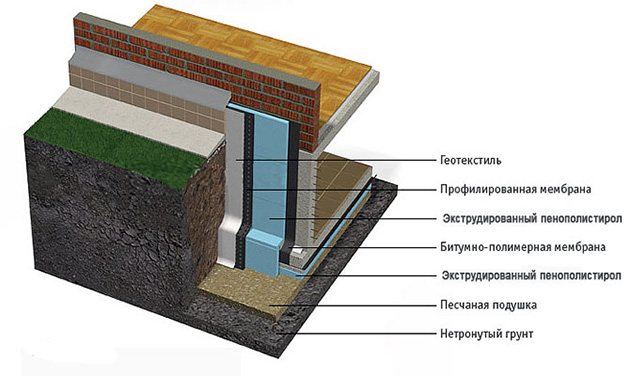

As you can see in the diagram, on top of the heat-insulating layer, you can additionally lay a protective covering made of geotextiles, although often the penoplex is simply covered with soil. Additional protection will not require a lot of costs, but it will significantly extend the life of the insulation. Details about the technology of warming foundations with expanded polystyrene using bituminous materials are shown in the video:
Another interesting way to insulate the base of a house without a basement is used in cases where the foundation is a solid concrete slab. The essence of the method lies in the fact that expanded polystyrene is laid on a sand cushion, and a monolithic concrete base is poured over it. At the same time, it is possible to immediately lay a heating circuit of warm floors inside the monolith. This design is called the Swedish plate, the diagram of its device is shown in the figure:


It can be seen here that the Swedish slab belongs to shallow foundations, insulated not only from below, but also on the sides. In terms of energy efficiency, this technology is one of the best, but it requires a very meticulous approach to work. Failure to comply with technological requirements can lead to cracks in the slab and damage to the underfloor heating system.


The main disadvantage of the Swedish slab is the inability to carry out repairs in case of cracking. But if you lay the insulation of the slab correctly, then such a foundation will calmly stand for several decades. At the same time, the use of a solid slab is possible on various subsidence soils. In practice, this insulated structure is often used to build wooden houses instead of the traditional strip foundations.
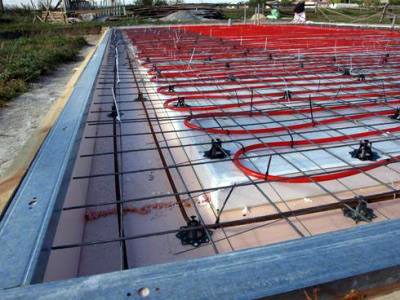

Watch our video on choosing thermal insulation


Thermal insulation keeps the base from freezing and mechanical damage
Such a structure will last much longer without major repairs. Condensation does not form on the walls of the insulated basement, this saves building materials from premature destruction.
Internal insulation has a similar function. As practice shows, external and internal insulation has the same result. The difference between them is only external.
Features of thermal insulation of the foundation with polyurethane foam
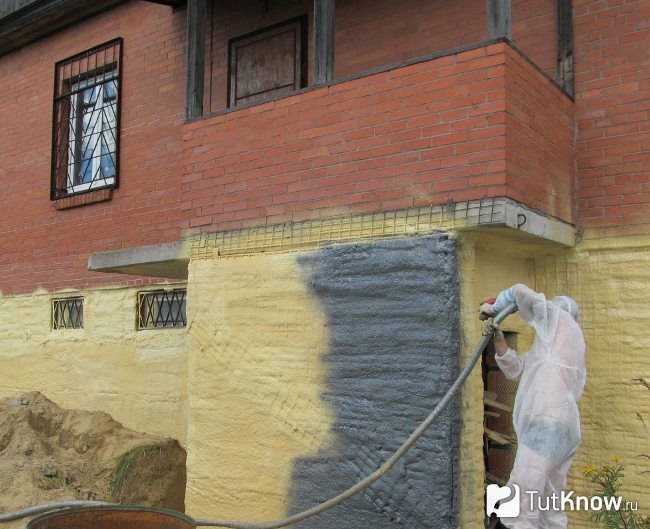

The main characteristic difference of basement insulation with polyurethane foam (PPU) is the way it is applied. Initially, the material is represented by two liquid components, which, after mixing, form a dense foam. It rapidly increases in volume and then hardens, creating a porous structure with excellent thermal insulation characteristics:
- Density - about 60 kg / m3;
- Weight - about 1.8 kg / m2 of coating t. 30 mm;
- Thermal conductivity - 0.025 W / mk, which is two times lower than that of mineral wool;
- The operating temperature range is from -100 to +100 degrees.
To insulate the foundation, a special installation is required that generates foam and raw materials. The foam composition is applied using a spray gun included in the equipment set. Thermal insulation of foundations is performed with rigid polyurethane foam, having a density of at least 32 kg / m3.
It can be applied to the inner and outer surfaces of foundation walls. Internal thermal insulation is performed if it is not possible to make external PPU spraying. In the process of insulating the buried structure of the building, foam is applied to the entire surface of the walls of the foundation along its perimeter; a layer of thermal insulation of at least 60 mm is considered reliable.
The polyurethane foam coating can be applied to the foundation at a temperature of at least +5 degrees and a wind speed of no more than 5 km / h. At the same time, the quality of its surface does not really matter, it is enough that it is clean. The foam set point is easy to determine as the finished coating changes color slightly.
PPU spraying work is performed in skin and eye protection equipment, although this material is not toxic. Extra precautions won't hurt. If foam gets on an area of the skin, it must be quickly washed off, and the problem area should be lubricated with a moisturizer.
In the process of spraying insulation on the foundation, various problems may arise associated with malfunctions of the foam generator, sprayer, neglect of the correct dosages of the mixture components or weather conditions. For example, cracks in the coating may appear after application at sub-zero temperatures. In addition, after polymerization, such an insulating layer has insufficient flexural strength.
In the finished thermal insulation of the foundation, only microcracks are permissible, the volume of which will not increase in the future. Through cracks must be immediately eliminated, since water can accumulate in them, which, when frozen, can damage the insulation layer of the foundation.
Insulation of a columnar foundation
To insulate such a foundation, a zabirka is created - a special type of base in the form of an interlayer between the ground and the foundation, which protects against moisture and temperature extremes. A pick-up is created in several stages:
- They dig a trench 20-40 cm deep.
- The trench is covered with rubble or sand by one third.
- Beams with grooves are attached to the pillars of the foundation.
- Special thin boards are inserted into the grooves.
- The lower part of the structure is filled with expanded clay.
Insulation of the pile foundation
Many are interested in how to insulate the pile foundation of a wooden house. A feature of buildings with this type of foundation is the presence of an air gap between the base and the soil, which, in the absence of thermal insulation, leads to significant heat losses. Therefore, the insulation of the pile foundation from the outside is a necessary measure, on which the comfort of the residents of the house depends.
- Before insulating the pile-screw foundation, waterproof the grillage.
- Install the insulation of the screw foundation.
- Finish the outer insulation layer.
Insulation of the base of the pile-screw foundation is carried out mainly with foam. Also, when insulating the pile-screw foundation of a wooden house, great attention is paid to high-quality waterproofing.
External insulation
Engineers have developed many ways to seal the outside of the foundation. They differ among themselves in the principle of action and the use of materials.
- Preparatory cleaning work around the foundation;
- Laying of materials and pipes for waterproofing;
- Insulation lining around the entire perimeter of the "sole";
- Finishes for added protection and a complete look to your home.
Read here - Do-it-yourself wardrobe: drawings, diagrams, projects and modern ideas for arranging a wardrobe (115 photos and videos)
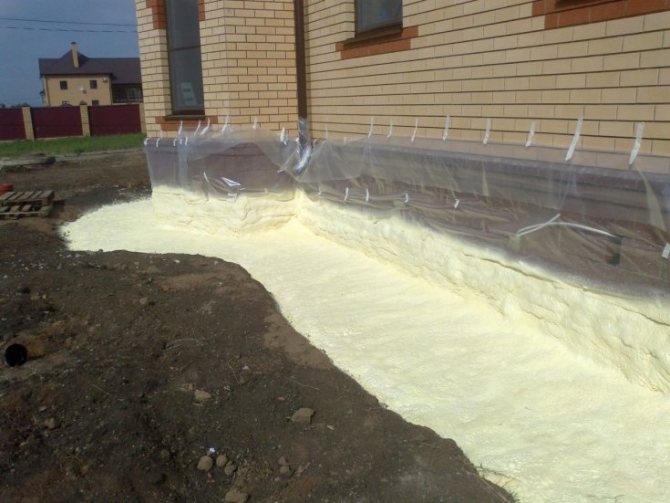

Dozens of different building materials can be used to finish the basement - fireclay brick, clinker brick, stone, porcelain stoneware, etc.
